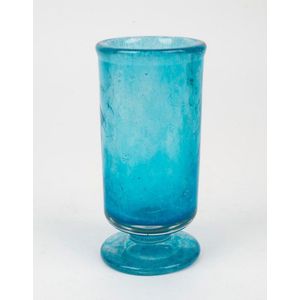1920 Schneider French Blue Crackle Glass Vase, Acid Etched
Schneider French blue crackle glass vase, circa 1920, acid etched 'Schneider, France', 17.5 cm high
You must be a subscriber, and be logged in to view price and dealer details.
Subscribe Now to view actual auction price for this item
When you subscribe, you have the option of setting the currency in which to display prices to $Au, $US, $NZ or Stg.
This item has been sold, and the description, image and price are for reference purposes only.
- Circa - A Latin term meaning 'about', often used in the antique trade to give an approximate date for the piece, usually considered to be five years on either side of the circa year. Thus, circa 1900 means the piece was made about 1900, probably between 1895 and 1905. The expression is sometimes abbreviated to c.1900.
- Crackling and Crackle as a Decorative Technique - Crackle, also known as crackling, is a decorative technique that has been used in China for centuries. It is believed to have originated during the Song Dynasty (960?1279 AD) and was primarily used in the production of ceramics, lacquerware, and furniture. The crackling effect was achieved by applying a glaze or lacquer that was formulated to crack during firing, creating a crackled pattern on the surface of the item.
During the Ming Dynasty (1368?1644 AD), crackle became a highly sought-after decorative technique, and it was used to create intricate and beautiful designs on ceramics and lacquer ware.
In Western decorative arts, crackle / crackling came into use during the Art Nouveau movement in the late 19th and early 20th century. The crackling effect was used to create a sense of movement and fluidity in the design of Art Nouveau pieces.
It was also used in the 1920s and 1930s during the Art Deco movement. - Acid Etched - Acid etching is often used on glass, metals, and stone to create decorative finishes or to prepare the surface for further treatment or coating. The process of acid etching involves applying an acidic solution, such as hydrochloric acid or nitric acid, to the surface of the material and allowing it to react with the surface. The acid etches away a thin layer of the material, creating a rough, uneven finish. Acid etching can be used to create a variety of different finishes, from a subtle matte finish to a more pronounced, textured finish.
- Etched - Glass decorated with an etched design, which is achieved through marking out the pattern, protecting the area that is not be etched, and then immersing the object in acid to dissolve the surface of the unprotected area. With some glass objects, such as cameo glass, there may be several layers of different coloured glass, and part of the top layer is dissolved leaving the bottom layer as the background. The longer the time of exposure of the object to acid, the deeper the etching.
The word etching is also sometimes used to describe another method of decoration, where wheel grinders were used decorate the surface, but this technique is usually known as engraving. - Crackle Glass - A finishing process for glass that causes fine cracks to appear in the surface, so that it looks like cracked ice.. The glass piece while still hot is immersed in cold water causing the surface to crack. It is them reheated to seal the cracks.
The process is believed to have been invented in Venice in the 16th century.
Crackle glass is also known as craquelle glass, abd in the United States as ice glass.
This item has been included into following indexes:
-
Schneider / Le Verre Francais (France)
- glass makers 134
- lamps and lighting 313
